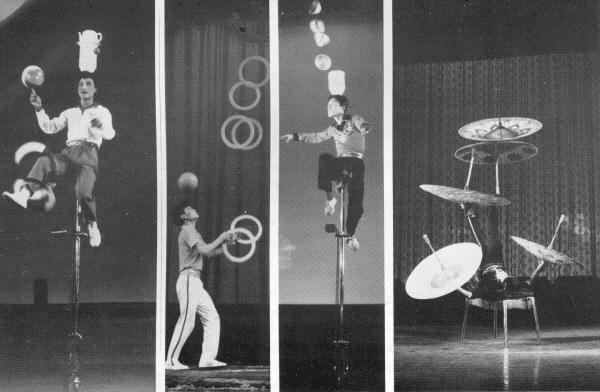|
Jian
Kang Qiu takes its place alongside wushu, taiji and other forms of
traditional Chinese exercise. Jian Kang Qiu, or as westemers know them,
palm rolls, are often done with two steel or jade balls.
This
exercise, usually performed by older men, is believed to keep the
person's hands nimble and because it is thought to benefit blood
circulation. Also
in a recent television broadcast of hospital workers doing exercises to
keep physically fit, juggling two balls with one hand took its place
alongside jumping rope and situps.
To
limit the discussion of juggling only to objects that are thrown and
caught with the hands is to overlook much of the juggling that is done
so exquisitely by Chinese performers. Chinese foot juggling is a
category that deserves mention. This art is divided into two types:
juggling light objects and juggling heavy objects. Both are performed
with the juggler lying on his or her back.
Some
of the lightweight things manipulated include umbrellas, rugs, fans,
hollow boxes and cylinders. In the category of weighty objects are large
jars weighing up to 30 pounds each. Sometimes round or square wooden
tables are manipulated. And at times stacked chairs or a ladder with one
or more balanced acrobats at the top are used. Perhaps the most
difficult object that can be manipulated by a foot juggler is another
acrobat.
Foot
juggling routines are often done simultaneously by two performers to
further heighten the visual beauty. Also, two performers can exchange
objects to intensify their performance.
After
discussing juggling that is done with the hands and feet, most people
are finished talking about juggling. But to stop here would be to ignore
three other types of manipulation in which Chinese performers show
amazing precision. First
there is the devil stick. Oftentimes four or five performers will do the
same routine in unison. Occasionally this will be done with each
performer manipulating not one, but two sticks at once.
The
diabolo is a top-like object that is usually spun on a string connecting
two short sticks. Dance-like body movements coordinated with high throws
and yo-yolike lowerings make diabolo play a visual favorite of Chinese
audiences. Again, several performers often work in unison, and
occasionally three or four spinning diabolos can be seen whirling on one
string as the performers engage in a game of catch that is itself a
juggle.
Jar
tricks are a form of manipulation that is uniquely Chinese. Although the
So
how does a young Chinese person become a juggler and a member of a
world-class acrobatic troupe? Of course, like anywhere in the world,
excellence stems from dedication, endless practice. expert coaching and
the quality that can neither be taught nor bought - talent.
In
the city of Xian
where the Shaanxi Acrobatic Troupe has its practice gym and
administrative offices, a young person can learn juggling or any of the
acrobatic skills by becoming a student at what resembles a middle school
and high school for acrobats .
The
various specialties that can be studied there include: jumping through
hoops on the ground, roller skating, cycling tricks, jar tricks, rope
twirling, juggling with the hands, handstands on movable blocks, foot
juggling with light and heavy objects, calisthenics (bending the body
backwards), rolling with a cup of water, kicking up and balancing bowls
on a unicycle, swinging meteors, spring board stunts, lion dance, wire
walking, comic performance, handstands on stacked chairs, the flying
trident and magic.
Becoming
a student with the Shaanxi
Acrobatic Troupe is not easy. There
A typical day of practice at school for aspiring young jugglers begins at 8 a.m. First there is a workout with the primary props - balls, rings, cIubs and/or badminton rackets. They may also work with some ancillary props that will later fit into a routine, such as juggling on a unicycle, spinning a basketball on the toe or balancing a stick on the forehead. All of this is done under the watchful eyes of several coaches who supply encouragement, know how and discipline when necessary.
|
